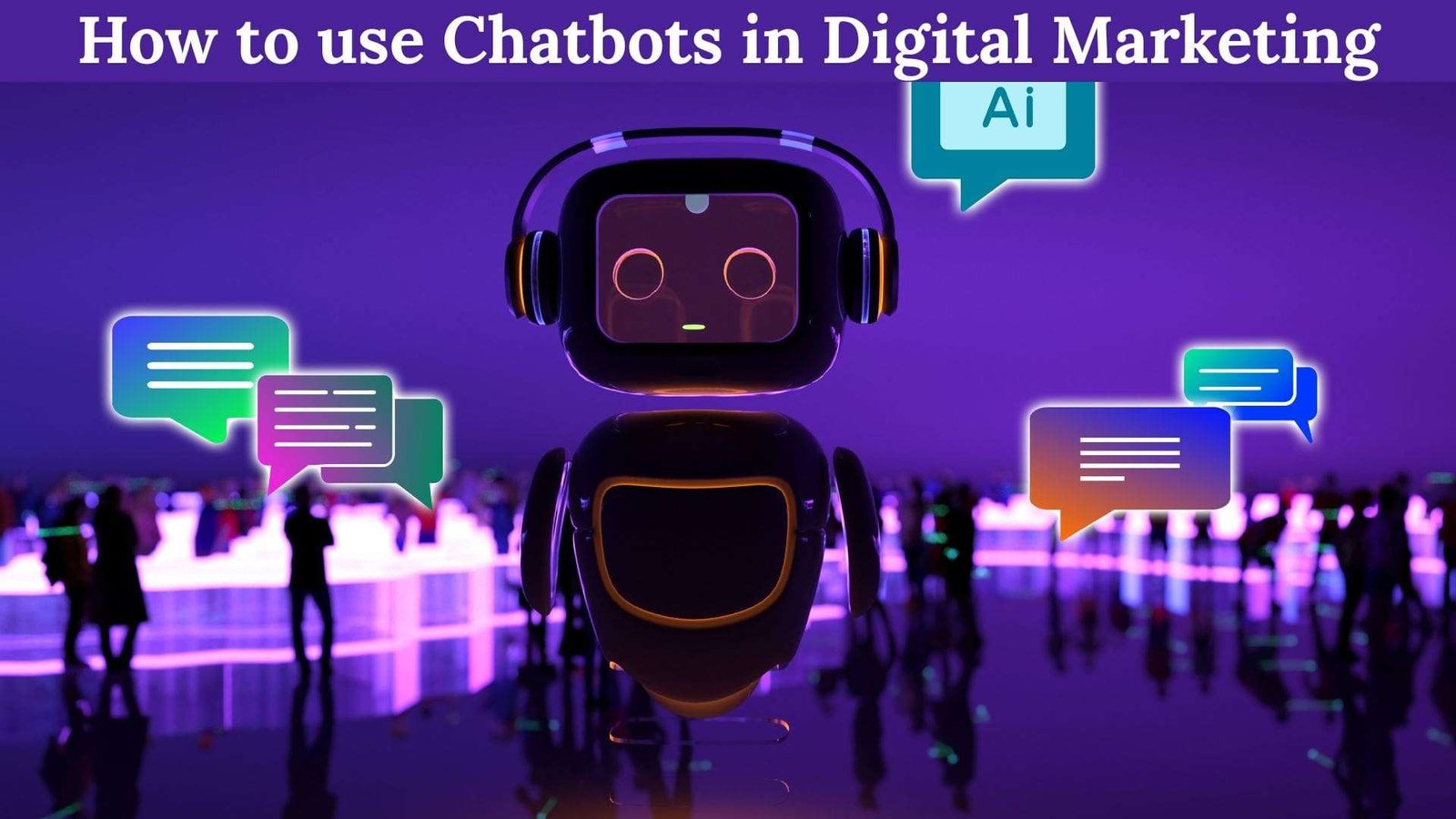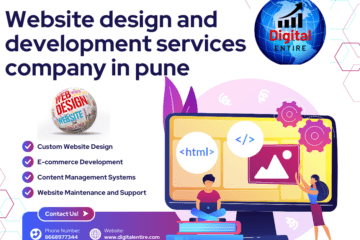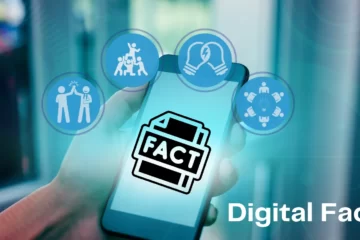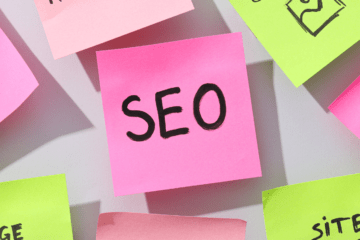How to use chatbots in digital marketing starts with integrating them across platforms like websites, social media, and messaging apps. Chatbots in marketing play a key role by providing instant replies, personalized experiences, and 24/7 customer support. They guide users, recommend products, and resolve queries in real-time.
Chatbots also collect user data and qualify leads through automated conversations. By using chatbots in marketing, businesses can streamline customer journeys, reduce bounce rates, and increase conversions. Their ability to automate follow-ups and nurture leads makes them powerful tools for engagement. Smart chatbot strategies lead to better user satisfaction and higher ROI.

Understanding Chatbots in Digital Marketing: A Smart Move for Business Growth
✅ What Are Chatbots?
🔹 Definition: Chatbots are AI-powered virtual assistants that simulate human conversation through text or voice interfaces.
🔹 Functionality: They interact with users on websites, apps, and social platforms, providing instant answers and guiding customer journeys.
🔹 Automation Role: Chatbots handle FAQs, collect data, recommend products, and even schedule appointments without human intervention.
🔹 Types: There are rule-based chatbots (with predefined responses) and AI chatbots for marketing that learn and improve over time using machine learning.
🚀 Why Chatbots Are Crucial in Today’s Digital Marketing Landscape
🔸 Real-Time Engagement: Chatbot digital marketing ensures immediate interaction with customers, reducing bounce rates and increasing satisfaction.
🔸 24/7 Availability: Unlike human agents, chatbots work round-the-clock, offering constant support and lead capture opportunities.
🔸 Personalized Experiences: AI chatbots for marketing analyze user data to deliver customized messages and recommendations.
🔸 Lead Generation and Qualification: Chatbots ask key questions, qualify leads automatically, and push them further down the sales funnel.
🔸 Cost-Efficiency: They reduce customer service costs by handling repetitive tasks, freeing up human resources for complex issues.
🔸 Multi-Platform Integration: Chatbots seamlessly work across websites, Facebook Messenger, Instagram, and WhatsApp, centralizing customer engagement.
🔸 Data Collection and Insights: They gather user behavior data, helping marketers refine campaigns and understand audience needs better.
📈 In summary, chatbot digital marketing is no longer optional—it’s a strategic advantage that drives engagement, conversion, and business growth.
Unlocking Customer Engagement: How to Use Chatbots in Digital Marketing for Better Results
🔹 Instant Responses and 24/7 Support
Chatbots provide real-time answers to customer queries, ensuring users receive immediate assistance without delays. This constant availability helps businesses support their customers anytime, day or night. Whether it’s resolving common questions or guiding users through a purchase process, round-the-clock service improves user satisfaction and encourages repeat visits. Fast, consistent responses significantly enhance retention by creating a dependable customer experience.
🔹 Personalized Interactions with AI
AI-based chatbots can tailor conversations using user data, behavior, and preferences. These smart tools analyze customer inputs to deliver relevant recommendations and offers that feel human and helpful. By personalizing messages, they build stronger connections and increase the likelihood of conversions. AI chatbots for marketing help deliver targeted communication, ensuring customers feel valued and understood throughout their journey.
🔹 Creating Seamless User Experiences
Modern chatbot systems integrate easily with websites, mobile apps, and social channels, offering users a smooth experience across platforms. This unified presence allows customers to engage effortlessly without switching contexts. When a query exceeds the chatbot’s scope, there’s a smooth handoff to human agents, maintaining a high level of service. Chatbot digital marketing strategies that focus on seamless experiences keep users engaged and reduce friction, enhancing brand loyalty.
Incorporating chatbots effectively can turn digital interactions into meaningful conversations that drive results and improve overall marketing performance.
The Power of Chatbots in Lead Generation for Modern Digital Marketing
🔹 Automated Lead Qualification
Chatbots can streamline the early stages of lead generation by asking pre-screening questions to identify genuine prospects. By analyzing responses in real-time, chatbots efficiently segment leads based on user intent, interests, and readiness to buy. This saves time for sales teams and ensures that only qualified leads are passed along. In modern digital marketing, this automation adds speed and precision to the lead pipeline without requiring manual input.
🔹 Collecting User Data Efficiently
One of the most valuable roles of chatbots is capturing essential user information such as email addresses, phone numbers, and personal preferences. These details are collected seamlessly during conversations, eliminating the need for intrusive forms. The chatbot can sync this data with CRM systems or email marketing tools, making follow-up campaigns more personalized and efficient. This approach not only improves data accuracy but also enhances the user experience.
🔹 Lead Nurturing Through Follow-Ups
Beyond initial engagement, chatbots play a critical role in lead nurturing. They can be programmed to send scheduled follow-up messages, reminders, or even personalized content and promotional offers. These consistent touchpoints help keep your brand top of mind and guide prospects further down the sales funnel. By automating these follow-ups, businesses maintain continuous engagement without overwhelming the customer, increasing the chances of conversion.
Top Platforms to Use Chatbots for Marketing and Customer Engagement
🔹 Website Chatbots
Websites are one of the most common platforms for deploying chatbots in marketing. These bots often appear as chat pop-ups on landing pages to engage visitors immediately. They can answer FAQs, recommend products, or guide users through the buying process. One powerful strategy is using exit-intent triggers—when a user is about to leave the page, the chatbot pops up to offer help, discounts, or collect lead information. This proactive engagement boosts conversions and reduces bounce rates.
🔹 Social Media Chatbots
Social platforms are ideal for chatbot digital marketing, offering seamless interaction within apps people already use. Facebook Messenger bots enable instant, automated communication with users—answering questions, booking appointments, and even processing orders. Additionally, Instagram and WhatsApp chatbots for business provide personalized interactions, helping brands reach users more casually and effectively. These AI chatbots for marketing boost visibility while maintaining a responsive, always-on presence.
🔹 Email and SMS Automation with Chatbots
Chatbots can also enhance traditional channels like email and SMS. Using interactive messaging, they can re-engage users who haven’t completed a purchase or opened previous campaigns. Trigger-based communication—such as sending a discount after cart abandonment—helps nurture leads and drive conversions. These chatbot-enabled automations personalize the user journey and increase ROI by delivering the right message at the right time.
💡 Deploying chatbots across multiple platforms ensures consistent engagement and maximizes marketing performance through automation and personalization.
Smart Ways to Use Chatbots Effectively in Your Marketing Strategy
🔹 Define Clear Marketing Goals
Before implementing a chatbot, it’s crucial to define its primary purpose—whether it’s customer engagement, support, or lead generation. Knowing your goal helps shape how the chatbot interacts with users and what kind of responses or actions it should trigger. Aligning the chatbot’s design with your marketing objectives ensures measurable outcomes and better performance.
🔹 Create Clear and Natural Conversation Flows
Effective chatbot digital marketing relies on smooth, intuitive interactions. Design clear conversation paths that guide users toward specific actions—like making a purchase or filling out a contact form. Avoid jargon, keep responses concise, and always include options for the user to choose from. Well-structured flows improve user experience and increase conversion rates.
🔹 Continuously Test and Optimize Performance
Regular testing is essential to identify weak points in your chatbot’s flow and improve accuracy. Analyze performance metrics like engagement rate, completion rate, and bounce rate. Use this data to make iterative improvements. AI chatbots for marketing become more efficient over time when they are fine-tuned based on real user behavior.
🔹 Use Human Handoff for Complex Issues
Even the smartest chatbot can’t replace human empathy and problem-solving. Always include a smooth handoff option that allows users to speak with a live agent when needed. This ensures users don’t get stuck in frustrating loops and maintains high satisfaction levels.
Best Chatbot Tools for Marketers to Automate Customer Interaction
🔹 Tidio
Tidio combines live chat and chatbot automation in a single, user-friendly platform. It’s ideal for small to medium businesses aiming to boost customer support and sales. Tidio helps automate FAQs, recover abandoned carts, and initiate conversations proactively, making it a valuable digital marketing chatbot solution.
🔹 ManyChat
ManyChat is a top choice for automating interactions on Facebook Messenger, Instagram, and WhatsApp. With its visual flow builder, marketers can create campaigns that capture leads, send updates, and offer instant replies. It’s especially effective for eCommerce brands looking to grow with minimal manual effort.
🔹 Chatfuel
Chatfuel enables marketers to build powerful Messenger bots without any coding. It supports lead generation, automated support, and customer feedback collection. Its integration with Google Sheets and CRM tools allows real-time data syncing, improving the efficiency of marketing automation.
🔹 Intercom
Intercom provides an advanced chatbot system designed for SaaS and enterprise-level companies. It’s excellent for onboarding new users, resolving support queries, and qualifying leads. The tool also blends automation with live chat, ensuring customers always get timely, relevant responses.
🔹 Drift
Drift focuses on real-time conversation marketing and is known for converting website visitors into qualified leads. Its bots engage users, schedule meetings, and pass hot leads directly to sales teams. Drift’s analytics help optimize every interaction for better outcomes.
💡 Chatbots in marketing streamline customer communication, enabling marketers to automate interactions, reduce response time, and improve conversion rates across channels.
FAQs
Q1: How do chatbots improve customer engagement?
Chatbots provide instant, personalized interactions that keep users engaged, answer queries, and create a smooth customer journey.
Q2: Can chatbots really generate leads for my business?
Yes, chatbots can qualify leads, collect contact info, and nurture prospects with timely follow-ups, boosting conversion rates.
Q3: What types of businesses can benefit from chatbots?
From e-commerce to service providers, any business that handles customer interaction can benefit from chatbot integration.
Q4: Are chatbot tools expensive or hard to implement?
Many chatbot tools offer affordable plans and user-friendly setup, making them accessible for small and mid-sized businesses.
Q5: How can I measure chatbot effectiveness?
Track metrics like engagement rate, lead capture rate, response time, and conversion to evaluate chatbot performance.
Table of Contents
Related Services – Digital Marketing Services SEO Services Social Media Marketing Content Marketing Services Best Digital Marketing Services Google My Business Services Web Design Services Digital Marketing & Web Design Facebook
Content Writing-GMB Experts In Pune, Digital Entire-Digital Marketing Company In Pune


